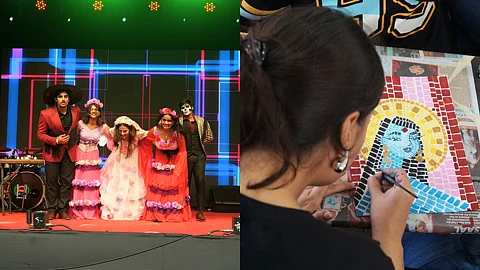
- HOMEGROWN WORLD
- #HGCREATORS
- #HGEXPLORE
- #HGVOICES
- #HGSHOP
- CAREERS
- ABOUT US
- CONTACT US

I was ten days into first year of college when I joined the Malhar workforce, the cultural festival of St. Xavier’s College, Mumbai. I applied for the same reasons everyone does: my friends were doing it, the seniors were intimidating and cool, and it would look great on my resume. I didn’t know then that it would become the most formative experience of my college life. I continued to come back every year till I graduated. I never expected to manage a team of forty people by the end of it. By the time the lights dimmed on the final day, everything was different. In who I am, and how I saw the infinite possibilities of building a culture from scratch.
College fests in India are truly homegrown creative ecosystems. They run on WhatsApp threads and favours, on borrowed speakers and broken printers, on over-ambitious ideas and the sheer will to pull them off. They don’t wait for funding or permission, but they’re often the first spaces where students encounter what it means to work in culture.
Take Waves, the annual cultural fest at BITS Pilani, Goa. It draws a footfall of nearly 60,000. “There are around 200 colleges that participate,” Adeesh, a former organiser, told me. “We run 40 events across eight categories.” They’re full-scale productions. One of their most popular events is Sizzle, a dance battle where performers only learn the song once they’re already on stage. A clip from this event went viral years ago. “Red T-shirt guy,” Adeesh laughs, “that YouTube video hit 10 million views.”
At VIT, Riviera is the cultural backbone of a campus better known for its technical rigour. “We get about 60- to 70,000 people,” Mrinal, a former organiser, estimates. The budget ranges from Rs. 1 crore to 2 crore. There are performances by comedians like Biswa and Gurleen Pannu. Musical acts like Pineapple Express and Javed Ali. But there are also lesser-known but deeply impactful events: debates, MUNs, design hackathons, theatre, spoken word. “It’s a different way of thinking. You’re constantly solving problems,” he says.
One of the most charming things about college fests is their controlled chaos. You think it’s going to fall apart. And then it doesn’t. I remember a night during the band competition. The crowd couldn’t hear a thing. It was windy, noisy. So we scrambled for mics from the college, borrowed speakers from friends’ rooms, hooked it all up with wires and duct tape. It worked. Everyone could finally hear.
That story is the norm. Jugaad is about cooperation, urgency, invention just as much as it’s about being scrappy. It teaches students that all creativity needs is collective effort. But what happens after the fest? What remains once the lights go off and the banners come down?
For Adeesh, the full impact of Waves didn’t hit until much later. “During my internship, I noticed the same workflows: task delegation, people management. It all felt familiar.” These spaces are often the only access point students have to the arts. “BITS is a technical college,” Adeesh points out. “There’s not a lot of institutional focus on the arts. But through Waves, students explore photography, music, and dance. Some end up getting really into it. It’s the only space in which they’re allowed to.”
This is especially true in campuses where creative work is seen as optional, or worse: unserious. But during fest season, the hierarchy collapses. A biotech student might find themselves managing artist hospitality. A computer science undergrad might be leading stage design. And in that late-night meeting or perfectly timed spotlight cue, the arts stop feeling like a hobby. They start feeling like work worth doing.
Fests build culture, but they also build community. Mrinal reflects on this often. “You work with people you’d never normally talk to. Across departments, years, and languages. You learn how to argue, how to listen. You fight and then make up because the show has to go on. You grow together.”
There’s also a sense of ownership that’s hard to replicate elsewhere. No one’s doing it for extra credit. They’re doing it because it matters to them, to their peers, and to the legacy of their college. Adeesh calls Waves “the biggest fest on campus — especially for first years. "Everyone is excited for it," he explains. "It kind of defines the rhythm of the year.”
And that rhythm lingers long after college ends. Those who’ve worked on fests often find themselves returning to that experience whether they end up in advertising, tech, journalism, or theatre. It’s a memory that’s also a skillset. India doesn’t have enough accessible entry points into cultural work. Internships are rare and often unpaid. Networking is hard if you don’t already know someone. But college fests are open. They let you build something real; something seen; something shared.
It’s easy to think of these festivals as just another chaotic campus event. But that would be a mistake. They are blueprints for what decentralised, student-led cultural infrastructure can look like. They’re where young people learn to produce, to negotiate, to improvise. They’re where culture gets made.
If you enjoyed reading this, here's more from Homegrown:
The Intersectionality Of Queer Cinema: How Fat Phobia Is Present In The Indian Queer Community
5 Underrated Regional Films That Portray The Everyday Reality Of Queerness In India
How Rituparno Ghosh's Filmography Explored Womanhood Through A Feminist Lens
